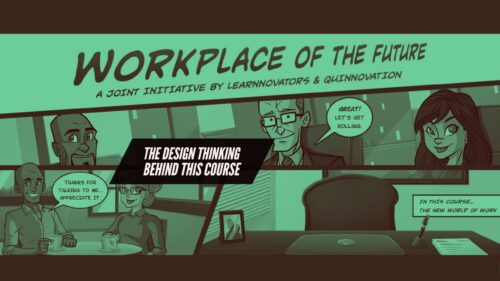How to Design a Course Using the eLearning Manifesto
Several years ago now, some colleagues and I shared our disappointment in the state of eLearning. We felt that the promise wasn’t being lived up to, and wanted to do something about it. Out of that frustration was born the Serious eLearning Manifesto, a plea for eLearning quality. We created a site and asked colleagues to sign on. We received support from 33 esteemed colleagues who agreed to serve as trustees, and major organizations in the field including ATD, the eLearning Guild, Training Magazine, and ISPI.
The initiative, co-authored with Michael Allen of Allen Interactions, Julie Dirksen of Usable Learning, and Will Thalheimer of Work Learning Research, stipulates eight core values that separate traditional eLearning from what ‘serious’ eLearning could and should be (inspired by the serious games movement). We backed up those values with 22 science-based principles that were distilled from research by scientists around the globe and across decades.
Since then, a number of people have continued to sign on, but we’re not seeing the impact we had hoped for. One of the potential barriers is some idea of what real eLearning could be, and how it can be done under the pragmatic constraints most organizations must adhere to. And that leads us to another recent project.
I had written a series of blog posts about good eLearning design for Learnnovators, an eLearning development firm, and we were looking for our next activity. We decided to create a project that practiced what we preached in a practical way. To make a long story short, we created a ‘Future of Work’ project. You can find out about the back story through a series of articles you can find linked here, but what I want to do here is examine the project in light of the Manifesto, something I haven’t done explicitly before, and I think is worth exploring.
To do that, let me briefly characterize the project. In essence, there are four modules, each addressing a core area of ‘the future of work’ (a tribute to the late Jay Cross). The coverage isn’t complete, but is intended to be representative. The topics are about the flow of information, meaningful work, working out loud, and a safe culture. You can experience it yourself.
So, here we go, value by value. How does this course play out as serious eLearning?
Performance Focused
The first value of serious eLearning is that it is performance-focused, not content-focused. What that means is that learners actually must perform, not just recite back information. We know that application of knowledge is critical for transfer, and that just reciting knowledge leads to what in cognitive science is ‘inert knowledge’: you can pass a test on it, but when you go out in the real world and there’s a relevant situation, it doesn’t even get activated!
So in our course, what we have learners doing is applying the knowledge to make decisions (see below). The content isn’t presented first, but instead the activities, the situations requiring the knowledge appear first. The content is available, but from within the activity, not a priori. In fact, learners can attempt the activities without seeing the content at all!
The goal is to ensure that the content is used in the service of achieving ends, not in and of itself.
Meaningful to Learners
The second value is that the course has to be meaningful to learners (versus efficient to develop). This means that we’re not taking PDFs and PPTs of content and adding a quiz, but instead we’re delving into the intrinsic interest of the course, and then manifesting that through the design.
In this course, this manifested in several ways. For one, we focused on a topic we believe is important (and yet, for practical reasons, isn’t one that was likely to have been created yet). And we knew why it was important, but we also tapped into the passion of our experts.
We then made sure that the objectives for each module were written in terms that learners should understand, not just what designers cared about. We had objectives for the modules, but they were written in WIIFM (What’s In It For Me) language.
The point is to do the work to figure out or extract the intrinsic interest, and then represent it, not just do what’s easy.
Engagement-Driven
The third element of the manifesto is that learning should be engagement-driven (not by attendance only). This mean a couple of things: learners doing meaningful things (see above) but also engaging them emotionally so that there’s an anticipation and a lack of complete predictability.
We did a couple of things. For one, we choose a graphic novel/comic visual style, and used a talented artist to render the images. We also sweated over the dialog, tuning it to be mostly natural, but a little idiosyncratic. And we made somewhat off-beat choices on the products that were discussed as the basis for the work. We also had challenge, in that the tasks were not overly simple.
In short, it’s not just about them having to do it, and going through it, but helping create an experience, not just an event.
Authentic Contexts
Here we mean contextualizing the learning, versus asking learners to apply the knowledge to abstract problems. Working across real contexts leads to better learning retention and transfer than abstract problems. You want learner actions happening in a plausible setting.
Of course, we didn’t have companies ‘to hand’ doing this (this is the future of work, after all), and we wanted leeway to do a wee bit of exaggeration over real life for engagement (see above). So we created plausible scenarios that folks could face, but in made-up companies, not real ones. This made it easier to create the contexts, but meant that we had some real thinking required to develop appropriately matched situations.
What we want is to create realistic setting in which to have learners perform, not abstract ones that will minimize the ability to transfer.
Realistic Decisions
When we need to create the highest likelihood of developing learner ability, what we want to do is minimize the distance between what learners do in learning and what we need them to do after the learning. And, I will suggest, that what will make the biggest impact on organizational success will be learners making better decisions than they are capable of before the learning experience.
In this case, we mapped the concepts behind the future of work components to specific decisions that would require them to use the knowledge. It took some iteration, but we ended up creating situations where the learners needed to use the principles to make workplace decisions. They were interacting with executives or their team, and needed to use the concepts to figure out what to do.
Decisions are the concrete alternative to knowledge testing, and a better basis for learning to do.
Individualized Challenges
One of the ways that eLearning can be better than the classroom is by taking advantage of programmable interactions so that a learner’s choices aren’t responded to in the same way by all. If you and I make different choices, then we should get different responses, which is hard in a group. Yet with eLearning, this possibility can and should be captured.
In our situation, the choices were complex, and feedback didn’t occur right away. The actions had either a series of branches, or complex combinations as possible responses, and what happened at the end was very dependent on learner choices. For instance, in one interaction you could get a result that matched one, another, both, or neither of the possible desired outcomes. The outcomes were represented differentially.
Even if you don’t go as far as we did, you should at least provide different feedback for each wrong answer (as the alternatives to the right answer should be ways that learners reliably and differentially go wrong).
Spaced Practice
For learning to be retained over time, practice needs to be spaced. For most anything of reasonable complexity, persistence of the learning requires reactivation and reapplication. Strengthening the connections that constitute learning can only be raised so much in any one day before our brains needs sleep. Thus, most learning should be extended over days, and even weeks.
In this area, our sample project was not critical to immediate outcomes. First, this was a demo of better design, and we only touched on bits of each of several modules. We were exhibiting the experience rather than making a definitive case (which we then wouldn’t have felt comfortable releasing for free!). There are several things that could’ve been done, including creating a discussion group with specific assignments, or spacing out some reactivation tasks via mobile. Given the parameters of our project, this didn’t make sense, but it wouldn’t have been an overwhelming addition in general for organizations with social networks and/or a learning management system.
In general, learning needs practice spaced over time to achieve the necessary retention to support successful transfer back to the workplace.
Real World Consequences
The final value is for there to be consequences for the decisions in the created context to mimic what will happen in the real world. This is important, as in real performance there will be consequences that need to be predicted and monitored. Principled formal feedback can come after the consequences, but the consequences themselves are both motivating and educational.
In this case, we had the learning experiences convey the outcomes of the decisions, whether interpersonal relations or business outcomes, at the conclusion of the activity, but still within the context. So, you could make choices and your team would finish the conversation, but their subsequent choices could include leaving the company or making more mistakes. It was only after the consequences that we provided more conceptual feedback.
While principled conceptual feedback can come afterwards, it is important to let the consequences be seen to emphasize the learning rationale.
Conclusion
Both the Future of Work project and the Serious eLearning Manifesto were efforts to evangelize better eLearning practice, they weren’t explicitly linked. In this case, we can use them together to illustrate the ideas and make more concrete what is possible. Good eLearning is doable and desirable. The alternative is highly likely to be ineffective, and that outcome doesn’t sound like, well, a good business decision.






